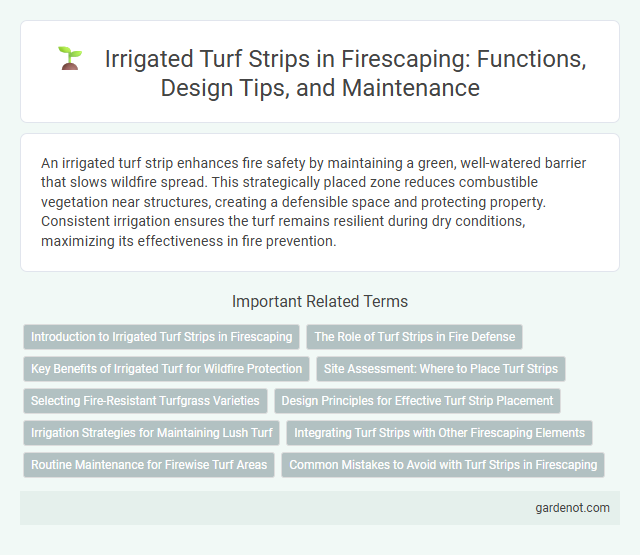An irrigated turf strip enhances fire safety by maintaining a green, well-watered barrier that slows wildfire spread. This strategically placed zone reduces combustible vegetation near structures, creating a defensible space and protecting property. Consistent irrigation ensures the turf remains resilient during dry conditions, maximizing its effectiveness in fire prevention.
Introduction to Irrigated Turf Strips in Firescaping
Irrigated turf strips serve as effective fuel breaks in firescaping by creating low-flammability zones that help slow wildfire spread near structures. These green, well-watered grass areas reduce fire intensity and provide defensible space, enhancing overall landscape fire resilience. Properly maintained irrigated turf strips integrate seamlessly with other fire-resistant landscaping elements to protect property and improve safety.
The Role of Turf Strips in Fire Defense
Irrigated turf strips serve as effective firebreaks by reducing fuel loads and maintaining moist ground conditions that slow fire spread. These green corridors help interrupt continuous vegetation, creating defensible spaces around structures and reducing ember ignition risks. Properly maintained turf strips enhance landscape resilience and contribute to an integrated firescaping strategy.
Key Benefits of Irrigated Turf for Wildfire Protection
Irrigated turf strips create a moist barrier that significantly slows wildfire spread by reducing flammable vegetation. Consistent irrigation maintains lower surface temperatures and increases green fuel moisture content, enhancing landscape resilience during fire events. This strategic green zone also serves as an accessible firebreak, supporting firefighter safety and containment efforts.
Site Assessment: Where to Place Turf Strips
Irrigated turf strips require careful site assessment to balance fire safety and landscape functionality. Place turf strips in areas with lower fire risk, such as near patios, walkways, or around structures, to create effective fuel breaks. Evaluate soil moisture, sun exposure, and slope to ensure optimal irrigation efficiency and turf health in fire-prone zones.
Selecting Fire-Resistant Turfgrass Varieties
Selecting fire-resistant turfgrass varieties such as buffalo grass, Bermuda grass, and fescue reduces landscape flammability while maintaining drought tolerance and aesthetic value. These species exhibit lower resin content and slower combustion rates, enhancing the safety of irrigated turf strips in fire-prone areas. Proper irrigation management combined with fire-resistant turfgrass creates defensible spaces that mitigate wildfire risk effectively.
Design Principles for Effective Turf Strip Placement
Irrigated turf strips should be strategically placed as defensible space zones to slow wildfires and reduce radiant heat near structures. Designing turf strips with appropriate width, typically 10 to 30 feet, helps create an effective barrier by minimizing combustible vegetation that can ignite easily. Selecting fire-resistant grass species combined with regular maintenance ensures optimal hydration and lower fire risk, enhancing overall landscape fire safety.
Irrigation Strategies for Maintaining Lush Turf
Irrigation strategies for maintaining a lush irrigated turf strip prioritize deep, infrequent watering to encourage strong root growth and drought resistance. Utilizing drip irrigation or rotary sprinklers with smart controllers ensures precise water delivery, minimizing runoff and evaporation. Regular soil moisture monitoring optimizes water use, promoting dense, healthy turf while conserving resources in fire-prone landscapes.
Integrating Turf Strips with Other Firescaping Elements
Irrigated turf strips serve as effective firebreaks when strategically integrated with drought-resistant shrubs and gravel mulch in firescaping designs. These turf strips maintain moisture levels that reduce fire intensity while creating visually cohesive transitions between hardscapes and native plantings. Incorporating drip irrigation systems enhances turf health and sustainability, optimizing fire control and landscape resilience.
Routine Maintenance for Firewise Turf Areas
Routine maintenance of an irrigated turf strip in Firewise landscapes involves regular mowing to maintain a height of 3 to 4 inches, which helps reduce fire intensity by retaining moisture and minimizing dry grass accumulation. Consistent irrigation is essential to keep the turf healthy and green, thereby creating a natural fire-resistant barrier around structures. Removing dead grass, leaves, and other debris prevents potential fuel buildup and supports a defensible space that conforms to Firewise landscaping standards.
Common Mistakes to Avoid with Turf Strips in Firescaping
Planting irrigated turf strips too close to combustible materials increases fire risk, undermining firescaping efforts. Overwatering turf strips can lead to heightened humidity and fungal growth, which may weaken plant health and fire resistance. Avoid installing turf strips without a proper maintenance plan, as neglected grass can become dry and highly flammable during drought conditions.
Irrigated turf strip Infographic

 gardenot.com
gardenot.com